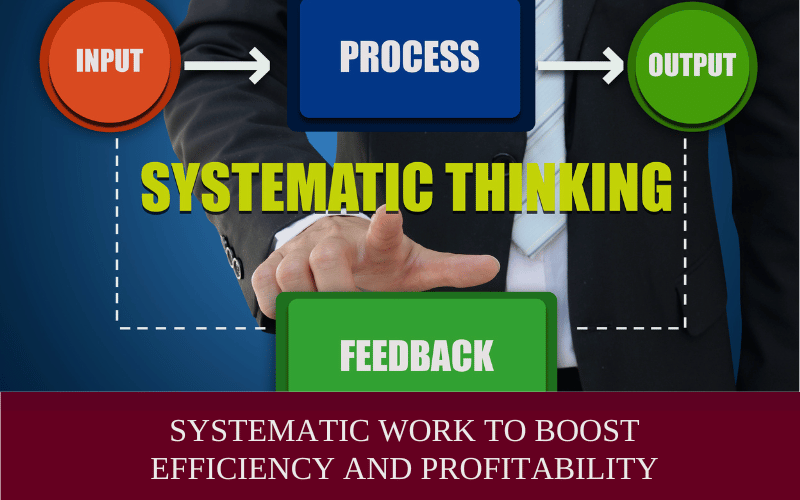
by Annika Sorensen | | Leadership & Corporate
In today’s fast-paced business world, staying efficient is essential to maintaining profitability. Many leaders strive for higher profits, but the secret lies in implementing a systematic work approach. This isn’t just about checking boxes—systematic work ensures a structured, repeatable process that prevents workplace issues and promotes seamless operations. In Sweden, businesses with 10 or more employees are legally required to adopt a written structure, but no matter where you’re located, building a solid framework can elevate your company’s performance.
Let’s explore what systematic work is, how it benefits your organization, and how to implement it effectively.
Why Systematic Work Matters for Your Business
A systematic approach in business is more than just following rules; it’s about streamlining every part of your operations. From policies to task allocation and risk prevention, a solid structure benefits both employees and employers. Companies that implement systematic work strategies enjoy fewer workplace accidents, higher efficiency, and better profitability.
For example, one of my collaborations with EldUpphör, a Swedish company specializing in fire prevention, showcased how impactful systematic work can be. Together, we created an online framework for a client struggling with document organization. While they had all the necessary policies, the lack of a clear structure led to wasted time and inefficiencies. Over nine months, we built and implemented a streamlined system where documents were easy to access and revise. The result? The client significantly reduced operational hurdles and improved productivity.
As a medical doctor, I’ve brought a unique perspective to such projects. My focus extends beyond physical setups—like chairs or desks—to the people involved. This approach ensures that solutions aren’t just technical but also human-centered.
How to Implement Systematic Work in Your Business
To create an effective framework, focus on these key elements:
- Document Policies and Procedures: Ensure all rules, responsibilities, and plans are clearly written and accessible.
- Task Allocation: Define who is responsible for what tasks and establish timelines.
- Emergency Preparedness: Create plans for potential issues and protocols to mitigate risks.
- Regular Reviews: Schedule periodic evaluations to keep your structure up to date.
Think of it like organizing your kitchen. When everything has a designated place and process, it’s easier to work efficiently without unnecessary delays. Similarly, a structured business system simplifies operations and minimizes errors.
Some organizations might need a complete overhaul, while others only require fine-tuning. If you’re unsure where to begin, consider consulting with an expert.
YOUR Path To Long-Term Success
Implementing a systematic way isn’t a one-time effort. It’s an ongoing process of refinement and improvement. Start small by organizing current processes and policies, and evolve from there.
As leaders, your role is to guide your organization toward sustainable practices. A systematic approach empowers teams to work smarter, not harder, while aligning every action with the company’s objectives.
If you’re ready to implement a structured system that saves time, reduces risk, and enhances profitability, download my free eBook: A Leader’s Guide to Systematic Success. It’s packed with actionable strategies to help you achieve more with less stress. If you have any inquiry, do not hesitate to contact us here.
Keep smiling, and stay systematic!


by Annika Sorensen | | Stress
Balancing corporate responsibilities and family life can feel like a constant tug-of-war. Yet, for high-performing professionals, embracing the intersection of parenting and leadership offers more than just survival—it offers growth. The traits that make a great leader often mirror those that make a great parent: empathy, clarity, decision-making, and the ability to inspire.
This article explores actionable strategies to navigate these dual roles, turning the balancing act into a sustainable rhythm.
The Parallel Skills of Parenting and Leadership
Mastering Time Management As A Parent & Leader
Whether it’s a boardroom deadline or a bedtime routine, both parenting and leadership demand precision and flexibility. One effective technique is time-blocking: segmenting your day into dedicated blocks for specific tasks. For example, mornings can be reserved for deep work, late afternoons for family errands, and evenings for rest.
Tech tools like Google Calendar, Trello, or Notion help streamline planning across both personal and professional domains. Shared calendars for the household can also help manage appointments, school events, and chore rotations. The goal? Quality presence over constant presence.
Delegation is another critical skill. Leaders who delegate effectively at work should also embrace shared parenting responsibilities at home. Leveraging both professional teams and family support helps reduce overwhelm and empower others.
Prioritizing Self-Care
Ignoring personal well-being leads to diminished effectiveness in both roles. Self-care doesn’t have to be extravagant—small, consistent actions make a difference. Here are a few simple practices you can incorporate into your day:
- Take a 10-minute walk between meetings
- Practice deep breathing or short guided meditations
- Enjoy a hot cup of tea without multitasking
- Journal your thoughts for 5 minutes each morning or evening
- Commit to a regular bedtime routine for better sleep quality
When leaders model self-care, both teams and families benefit from a calmer, more present version of you. Normalize asking for help, whether it’s from a coach, therapist, or your partner. High-performing leaders often feel guilt around slowing down, but rest is a strategy, not a weakness.
Building Stronger Bonds Through Parenting and Leadership
Communication That Connects
Strong leaders communicate with clarity, empathy, and transparency—traits just as essential at home. Whether it’s a strategic meeting or a family conversation, listening actively and validating emotions fosters deeper trust. Tailoring your message to your audience—whether team members or children—is the bridge to effective communication.
Set healthy boundaries to prevent burnout. Designated work hours and device-free time at home help reinforce those lines. Communicate these boundaries clearly to both colleagues and loved ones to prevent resentment and confusion.
Cultivating Support Systems In Parenting And Leadership
Thriving in both leadership and parenting requires a robust support network. That includes competent team members, a reliable partner, and communities who understand the unique dual-role challenges. Executive peer groups, parenting networks, and mental health professionals can all offer perspective and encouragement.
Here are some practical ways to build your support system:
- Build a strong team at work: Delegate effectively and empower your team to take ownership.
- Communicate with your partner: Share parenting responsibilities and set expectations together.
- Lean on family and friends: Whether for childcare or emotional support, don’t hesitate to ask.
- Join parenting groups: These communities offer shared experiences and helpful insights.
- Use available workplace benefits: Look into flexible schedules, parental leave, and mental health support.
Leaders who proactively seek support model vulnerability and strength, encouraging others to do the same.
Parenting and Leadership: The Legacy of Integrated Leadership
The demands of parenting and leadership are real, but they don’t have to compete. When embraced together, they sharpen each other. Leadership becomes more human, and parenting gains structure and vision.
By applying core principles like communication, delegation, and self-awareness to both areas, executives can thrive in the office and at home. Remember: the lessons you teach as a parent and the example you set as a leader leave a lasting legacy.
If you’re ready to explore how to lead better at work and at home, start with small, consistent changes—and don’t hesitate to reach out for mentoring or download our free e-book on work-life clarity.
Parenting and leadership aren’t opposites. They’re partners.


by Annika Sorensen | | Stress
Welcome to the executive diet composition—a harmonious blend of nutrition and leadership designed to empower executives with the vitality needed to orchestrate success in every note of their professional journey.
The executive diet symphony is not merely a culinary guide; it’s a transformative composition that harmonizes with the challenges and triumphs of leadership.
Nutrient-Rich Foods for Mental Clarity
In the bustling world of executive leadership, maintaining mental clarity is paramount. One powerful ally in this quest is the carefully chosen assortment of nutrient-rich foods.
These culinary comrades not only tantalize the taste buds but also provide the brain with the fuel it needs to navigate the complexities of decision-making.
1) Leafy Greens for Cognitive Harmony
In the world of nutrition, leafy greens take center stage. Packed with vitamins, minerals, and antioxidants, they contribute to improved cognitive function. Greens like spinach, kale, and Swiss chard, have rich nutrient profiles.
2) Omega-3 Fatty Acids: The Brain’s Nutritional Maestro
Found in fatty fish like salmon, mackerel, and trout, omega-3 fatty acids are the nutritional maestros that conduct the brain’s cognitive harmony. These essential fats support brain health and are renowned for their role in enhancing memory and concentration, providing executives with a brain-boosting encore.
3) Berries: Nature’s Brain Candy
For a delightful and nutritious brain treat, turn to berries. Blueberries, in particular, are laden with antioxidants that support brain function. Their sweet burst of flavor is not only a delectable addition to the executive diet but also a natural way to foster mental clarity.
4) Nuts and Seeds: Tiny Packages of Brainpower
In the realm of snackable brainpower, nuts and seeds reign supreme! Almonds, walnuts, chia seeds, and flaxseeds offer a potent mix of omega-3 fatty acids, antioxidants, and fiber, making them convenient and nutritious choices for executives aiming to sustain mental clarity throughout the day.
5) Hydration…Water for Cognitive Renewal!
Amidst the dietary symphony, let’s not forget the pure elixir of life – water. Staying hydrated is fundamental for optimal cognitive performance. A well-hydrated executive is better equipped to tackle challenges with clarity and focus.
In the executive diet, these nutrient-rich foods compose a harmonious melody that resonates with mental clarity.
As we delve into the subsequent subtopics, we’ll continue our culinary exploration, seeking the perfect ensemble for the demanding stage of executive leadership.
Balancing Energy Levels with Proper Nutrition
In leadership, aside from mental clarity, maintaining optimal energy levels is also more than a necessity—it’s a strategic imperative.
Here’s your reference to sustain the endurance required for the executive journey.
1) The Power of Protein: A Steady Source of Executive Energy
Our culinary exploration continues with the foundational element of sustained vitality: protein. Incorporating lean protein sources such as chicken, tofu, and legumes ensures that executives enjoy a sustained release of energy, keeping them sharp and focused through the demands of the day.
2) Complex Carbohydrates: The Fuel for Endurance
Enduring vitality requires a continuous supply of fuel. Complex carbohydrates take center stage, providing the energy needed for prolonged stamina. Whole grains, sweet potatoes, and quinoa become the nutritional allies that prevent the energy rollercoaster, maintaining stable blood sugar levels for unwavering focus.
3) Strategic Snacking: Nourishing the Executive Engine
Snacking emerges not as a diversion but as a strategic move in the executive playbook. Nuts, seeds, and Greek yogurt, carefully chosen, serve as convenient and nutritious companions, preventing energy dips and ensuring executives stay fueled without succumbing to the midday slump.
4) Caffeine Consciousness: Harnessing the Stimulant Wisely
In the executive diet, the allure of caffeine beckons but demands a mindful approach. Executives can harness the benefits of coffee or tea for a temporary energy boost, understanding that moderation is the key to avoiding potential drawbacks like jitteriness or disrupted sleep patterns.
Timing Matters: Executive Nutrition on a Schedule
Our nutritional strategy, much like a well-timed symphony, requires precision.
Planning meals and snacks at regular intervals becomes paramount, preventing energy crashes and sustaining the executive engine throughout the demands of leadership.
And of course, aside from good food and timing, as mentioned just a while back, hydration.
Hydration for Cognitive Performance
Let’s dive into the vital role of water in sustaining the executive mind.
1) The Elixir of Life: Hydration as a Cognitive Performance Enhancer
Amidst the demands of executive leadership, the elixir of life takes the form of water—a fundamental component for sustaining optimal cognitive function. Hydration, often overlooked, is a silent conductor shaping the executive’s ability to navigate challenges with clarity and focus.
2) Thirsty Minds: The Dehydration Cognition Connection
A thirsty mind is a mind in need. Dehydration, even in its subtlest forms, can impair cognitive performance. Executives, engaged in the intricate dance of decision-making, benefit significantly from maintaining well-hydrated minds, ensuring mental acuity doesn’t waver.
3) Water Breaks: Strategic Pauses for Cognitive Renewal
In the executive diet, water breaks are not just intervals for hydration; they are strategic pauses for cognitive renewal. As leaders navigate complexities, a sip of water becomes a moment of reflection, allowing for a mental reset and enhancing the ability to approach challenges with a refreshed perspective.
4) Hydration Habits: Crafting a Fluid Routine for Executive Wellness
Crafting hydration habits is akin to composing a fluid routine for executive wellness. From carrying a reusable water bottle to integrating hydrating snacks like cucumber or watermelon, executives can seamlessly weave hydration into their daily rhythm, ensuring sustained cognitive performance.
Beyond H2O: Exploring Hydration-Boosting Infusions
The hydration interlude wouldn’t be complete without exploring beyond H2O. Infusions with slices of citrus, mint, or cucumber add a refreshing twist to hydration, making it an enticing ritual for executives who seek not only cognitive benefits but also an enjoyable sensory experience.
But, all these… as a leader. Would it all be possible, given the all-the-time tight schedule?
Strategies for Healthy Eating on a Tight Schedule
Ah, the crescendo of executive leadership, where time is a scarce currency, healthy eating often takes a back seat.
However, our executive diet symphony continues to compose strategies that harmonize with the fast-paced cadence of leadership, ensuring nutrition remains a priority even within tight schedules.
1) Micro-Moments of Nourishment: Elevate Nutrition in Short Breaks
Executives, often engulfed in back-to-back meetings, can leverage micro-moments for nourishment. Whether it’s a handful of nuts, a piece of fruit, or a nutrition-packed smoothie, these bite-sized choices become the nutritional notes that compose a melody of sustained energy throughout the day.
2) Portable Nutrition: Transforming Snacking into Executive Fuel
Snacking, when done strategically, transforms into a portable source of executive fuel. Stocking up on trail mix, Greek yogurt cups, or pre-cut veggies with hummus provides quick and nutritious options, ensuring that even the busiest schedules don’t compromise nutritional excellence.
3) Culinary Efficiency: Batch Cooking for Executive Wellness
Efficiency becomes an executive’s ally in the culinary realm. Batch cooking, where meals are prepared in advance and stored, not only saves time but ensures that executives have access to wholesome, home-cooked options despite their demanding schedules.
Mindful Meal Planning: A Symphony of Nutrient-Rich Choices
Meal planning takes center stage as a mindful symphony of nutrient-rich choices.
Executives can allocate dedicated time to plan their meals, incorporating a variety of proteins, whole grains, and colorful vegetables, ensuring a well-rounded and nourishing diet.
These strategies form the harmonious notes that resonate with the challenges of a tight schedule.
And don’t forget, the power of…
SOME SUPPLEMENT for Stress Management
In the spotlight of stress management, vitamin D emerges as a sunlight nutrient that elevates mood and supports overall mental well-being. For executives with limited sun exposure, considering vitamin D supplements becomes a strategic move to enhance resilience against stress.
To conclude…
Embracing a comprehensive approach that combines nutritional strategies with targeted supplements, executives can cultivate a harmonious well-being that resonates with the challenges and triumphs of leadership.
As we wrap up our executive diet guide, let this harmonious ensemble serve as a guiding melody for executives seeking to navigate the demands of leadership with grace, resilience, and optimal well-being.


by Annika Sorensen | | Stress
One of the most common and unavoidable types of stress in leadership is financial stress.
But since the signs are subtle, and because it’s common, it sometimes goes unnoticed until it’s too late and has already taken a toll on you.
Hence, recognizing the signs and understanding how they manifest in leadership roles is vital to prevent drastic effects.
SIGNS OF FINANCIAL STRESS
1. Unusual Behavioral Changes such as increased irritability, withdrawal, or difficulty concentrating.
2. Changes in Decision-Making Patterns like noticeable alterations in decision-making processes, like hesitation, indecisiveness, or a sudden aversion to risk.
3. Impact on Interpersonal Relationships including strained relationships with team members, colleagues, or superiors, potentially stemming from heightened stress.
4. Physical and Emotional Well-being such as increased absenteeism or signs of burnout.
Remember, identifying signs of financial stress is the first step towards fostering a supportive environment for leaders. By recognizing these indicators, we can proactively work towards alleviating the impact of financial stress on leadership effectiveness.
But before recognition, an important step is prevention. And in prevention, strategies are a must. Below, you’ll find actionable strategies to prevent financial stress.
Strategies for Financial Wellness in High-Pressure Environments
Managing financial wellness is a critical aspect often overshadowed by the demands of the role. But financial stress is one of the types of stress that we’d all want to avoid. This subtopic dives into practical financial management tips tailored for leaders navigating high-pressure environments.
1. Budgeting for Leadership Success:
Practical Tip: Develop a leadership-centric budget that aligns with the unique financial demands of your role.
High-Pressure Context: Explore how effective budgeting can alleviate stress and provide financial clarity amidst high-pressure situations.
Real-Life Example:
John Chambers, former CEO of Cisco Systems, emphasized the significance of budgeting during challenging times. Through strategic financial planning, he guided Cisco through economic downturns, showcasing how a well-structured budget can be a pillar of stability in high-pressure leadership roles.
2. Strategic Debt Management:
Practical Tip: Implement strategies for managing and reducing debt while balancing leadership responsibilities.
High-Pressure Context: Understand how strategic debt management contributes to long-term financial well-being, even in the face of high-pressure situations.
Real-Life Example:
Dave Ramsey, a well-known financial expert and CEO, faced financial stress early in his career. Through disciplined debt management and financial education, he not only recovered but built a successful enterprise centered around financial wellness.
3. Investment Mindset for Leaders:
Practical Tip: Cultivate an investment mindset that aligns with leadership goals and timelines.
High-Pressure Context: Explore the connection between an investment mindset, leadership decisions, and financial resilience in high-pressure environments.
Real-Life Example:
Warren Buffett, renowned as one of the most successful investors and CEO of Berkshire Hathaway, exemplifies the power of an investment mindset. His strategic approach to investments and long-term vision have played a crucial role in both his leadership success and financial resilience.
4. Emergency Fund Practices:
Practical Tip: Establish and maintain an emergency fund specifically designed for leadership roles.
High-Pressure Context: Discuss the importance of having financial buffers in place to navigate unexpected challenges without compromising leadership effectiveness.
Real-Life Example:
Mary Barra, CEO of General Motors, understands the significance of an emergency fund. During periods of industry challenges, having a financial buffer allowed General Motors to weather the storm under her leadership.
Now, why do we need to implement these strategies? We don’t want financial stress to take a toll on our mental health after all, don’t we?
The Interplay Between Financial Stress and Mental Health
In leadership, the interplay between financial stress and mental health is often underestimated. Here, we will go through the psychological effects of financial stress on mental health and how it influences leadership effectiveness.
1. Cognitive Impact of Financial Stress:
Financial stress can impact cognitive functions, such as decision-making, problem-solving, and creativity. Just like general stress, financial strain can create a mental fog, making it challenging for leaders to navigate complex decisions and think innovatively. The burden of financial stress often occupies valuable mental bandwidth, diverting attention from strategic planning to immediate concerns about financial stability.
Real-Life Example:
Elon Musk, CEO of Tesla and SpaceX, publicly acknowledged the cognitive toll of financial stress during Tesla’s early struggles. Musk highlighted how the burden impacted his ability to make strategic decisions and underscored the importance of addressing mental health for sustained leadership success.
2. Emotional Well-being Amidst Financial Challenges:
Financial stress can also affect emotional well-being, leading to increased levels of anxiety, depression, or burnout. The weight of financial concerns can cast a shadow on a leader’s emotional landscape, impacting their overall mental health. The constant pressure to meet financial obligations and navigate uncertainties can contribute to heightened stress levels, potentially leading to emotional challenges.
Real-Life Example:
Sheryl Sandberg, Facebook COO, openly discussed the emotional toll of financial challenges following the sudden death of her husband. Her experience emphasizes the need for leaders to prioritize emotional well-being amidst financial adversity.
3. Long-term Effects on Leadership Effectiveness:
Aside from mental and emotional effects, it also has a long-term impact of sustained financial stress on a leader’s overall effectiveness. The chronic nature of financial stress can seep into various aspects of leadership, affecting decision-making, strategic planning, and the ability to inspire and guide a team. Over time, the constant juggling of financial challenges can erode a leader’s resilience and enthusiasm, potentially hindering their capacity to steer the ship with the same vigor and effectiveness.
Real-Life Example:
Warren Buffett, renowned CEO of Berkshire Hathaway, faced financial challenges early in his career. The perseverance he demonstrated in overcoming these hurdles showcases the long-term impact of sustained financial stress on leadership effectiveness. Buffett’s journey underscores the importance of resilience and strategic financial management in navigating the complexities of leadership over the years.
Open Conversations: Breaking the Stigma Around Financial Struggles
In the realm of leadership, a culture of silence often shrouds discussions about financial struggles. The fear of judgment and its potential impact on professional reputation can be a significant hurdle.
However, embracing openness about financial challenges is a gradual process. Leaders can start by initiating small, focused discussions within trusted circles, creating a safe space to share experiences.
One exemplary company leading the charge in destigmatizing financial struggles is Google.
Through employee resource groups focused on financial wellness, Google has created a platform for leaders to engage in discussions without fear of judgment. This initiative has not only fostered empathy but also strengthened connections among leaders.
Establishing support networks where leaders feel comfortable sharing their personal financial experiences presents its own set of challenges. However, mentorship programs that include financial well-being as a discussion point can serve as a workaround. This approach helps leaders connect on a deeper level, reducing isolation, and providing a platform for collective problem-solving.
Indra Nooyi, former CEO of PepsiCo, serves as an inspiring example. She actively advocated for open discussions on financial challenges, emphasizing the value of mentorship and peer support.
By breaking down barriers to discussing financial well-being, Nooyi contributed to a more supportive and connected leadership community.
Providing accessible and relevant financial education tailored for leaders is another crucial aspect.
Collaborating with financial experts to create targeted resources and workshops specifically designed for leadership audiences addresses this challenge.
Salesforce, for instance, offers financial wellness programs for its leadership team, supporting them in navigating financial challenges and contributing to a healthier work environment.
While breaking the stigma around financial struggles poses challenges, the positive rewards, exemplified by forward-thinking companies and leaders, showcase the transformative impact of fostering open conversations.
Now that we have the strategies for prevention and can recognize the signs, we must also have long-term solutions to sustain our long-term financial sustainability.
Long-Term Solutions for Sustainable Financial Health
1. Holistic Financial Planning:
Embrace holistic financial planning that encompasses short-term and long-term goals. Consider diversified investments for balanced growth, establishing leadership-specific emergency funds for unforeseen challenges, and integrating a robust retirement plan for financial confidence in the future.
2. Investment in Continuous Learning:
Promote a culture of continuous learning, encouraging leaders to stay informed about financial trends and strategies, and fostering adaptability and informed decision-making for a robust long-term financial strategy.
3. Mentorship for Financial Guidance:
Encourage leaders to seek mentorship for ongoing financial guidance throughout their careers, ensuring a lasting foundation for long-term financial health through personalized insights, strategic counsel, and continuous support.
A sustained financial health for leaders requires a proactive and integrated approach that aligns with the dynamic nature of leadership roles.
Conclusion: Nurturing Financial Well-being in Leadership
In the dynamic landscape of leadership, recognizing and addressing financial stress is crucial.
Real-life examples, from Elon Musk’s cognitive challenges to Sheryl Sandberg’s emphasis on emotional well-being, underscore the transformative power of financial wellness.
By breaking the stigma, fostering open conversations, and embracing holistic planning, continuous learning, and mentorship, leaders can navigate financial challenges with resilience.
Let these insights, plus more of these, guide you toward sustained financial health, ensuring a journey marked by confidence, wisdom, and long-term success!


by Annika Sorensen | | Stress
In the high-stakes world of executive leadership, clarity of thought, emotional resilience, and adaptive decision-making are paramount. That’s why more and more professionals are turning to the transformative power of mindfulness and executive functioning. Far from being a wellness trend, mindfulness is a science-backed strategy that strengthens the mental skills executives rely on every day.
Let’s explore how mindfulness enhances executive functioning—and why it might be the most underrated leadership tool of our time.
Enhancing Decision-Making Through Mindfulness and Executive Functioning
Mindfulness is the ability to stay present without judgment, while executive functioning encompasses core mental capabilities such as working memory, cognitive flexibility, and inhibitory control. Together, they empower leaders to respond—not react—in the face of pressure.
Executives who embrace mindfulness experience improved focus, reduced reactivity, and greater emotional regulation. One 2012 Harvard study revealed that just eight weeks of mindfulness meditation increased grey matter density in areas of the brain associated with memory, learning, and emotional regulation—all critical to executive function.
Real-World Practices for Better Decisions
- Micro-Mindfulness: Pause for three deep breaths before making a tough call or stepping into a high-stakes meeting.
- 4-7-8 Breathing: Inhale for 4 seconds, hold for 7, exhale for 8. Repeat 3 times to reset cognitive overload.
- Mindful Listening: Focus completely on the speaker during meetings—no multitasking. This builds trust and reduces misunderstandings.
As Janice Marturano, founder of the Institute for Mindful Leadership, proved through internal studies, 80% of leaders reported improved decision-making after mindfulness training.
Cultivating Emotional Intelligence with Mindfulness and Executive Functioning
Mindfulness doesn’t just fine-tune focus—it enhances emotional intelligence (EQ), a trait every effective leader needs. Emotional regulation, empathy, and interpersonal communication are all deeply rooted in healthy executive functioning.
Self-Awareness and Regulation
- Use mindfulness journaling to reflect on your emotional patterns.
- Employ a 5-minute guided body scan meditation to manage stress and improve awareness of how your body responds to pressure.
Strengthening Empathy and Connection
- Begin team meetings with a 60-second breathing practice to reset focus.
- Schedule periodic “mindful check-ins” to model emotional transparency and presence for your team.
Executives like Satya Nadella (Microsoft) and Marc Benioff (Salesforce) have long credited mindfulness practices for their leadership effectiveness. Whether it’s morning gratitude or tech-free focus zones, these habits are rooted in science and lead to measurable leadership outcomes.
Mindfulness and Executive Functioning: Rewiring the Executive Mind
Incorporating mindfulness and executive functioning into daily routines isn’t about slowing down—it’s about unlocking strategic capacity. From more effective meetings to healthier responses under pressure, the ROI of mindfulness extends far beyond personal wellness.
Build this skill like any other: consistently and with intention. Whether you start with 3 deep breaths or adopt a structured practice like meditation, what matters is consistency.
To begin your journey, download our free guide or explore leadership mentoring options designed to embed mindfulness into your executive playbook.
Mindfulness and executive functioning: your most sustainable competitive advantage.








